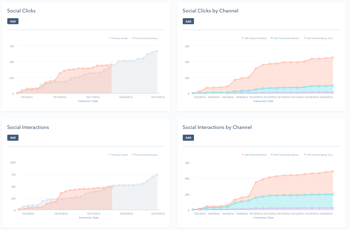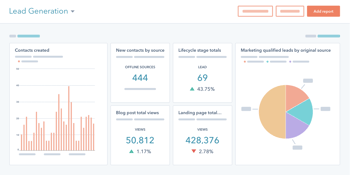
Cutting-Edge Marketing to Grow Your Business.

If you’re running a business, then you need to be paying attention to inbound marketing metrics. Inbound marketing is all about generating leads through content and nurturing them until they turn into customers. And the only way to know if your inbound marketing campaigns are working is by measuring your results.
That’s why we’ve put together this article outlining the 5 most important inbound marketing metrics. By understanding these metrics, you can determine which campaigns are working and which ones need improvement. So read on and learn how to use inbound marketing metrics to drive success for your business!

Monitoring inbound marketing metrics is an important step in improving the overall inbound marketing performance. It helps you to identify which channels are performing the best, as well as which campaigns need improvement. Knowing the inbound marketing metrics enables you to adjust your inbound marketing strategy in order to maximize return on investment.
One mistake many businesses make in inbound marketing is generating content without a strategy or without monitoring results. This has a direct impact on the type of decisions that need to be made as your strategy is deployed. For example, if you launch a brand awareness campaign, how do you know what to measure to show success? Normally a campaign driving brand awareness focuses on SEO and lead generation, so you'd have to identify those metrics that will show your ROI. If your goal is to boost sales figures and you decide to use email marketing and paid media, then you'll have to adjust your metrics as well.
Below you'll find the 4 most important metrics for inbound marketing.

Measuring website traffic for inbound marketing is one of the most important metrics in measuring success. Understanding where your website visitors are coming from, what content they’re engaging with and for how long, in addition to understanding the quality of those visits, will help you better understand the effectiveness of your inbound campaigns.
You should track each source separately in order to differentiate between organic search, referral sites, social media and other channels. By evaluating the number of visitors from each inbound channel as well as how much time they spend on your site, you’ll be able to determine which inbound channel is most effective at driving leads and potential sales. Additionally, modern tools like Google Analytics and heatmaps can provide valuable insights into visitor behavior such as what pages they visit, which keywords they use in organic searches or even how far down a page they scroll before leaving.


Social media platforms are great avenues to reach potential customers in a way that feels more natural and conversational. It allows you to nurture relationships, build trust, and engage people in a meaningful way.
To measure the effectiveness of inbound marketing on social media, you should track the number of followers, likes, shares, comments, and impressions per post. This will give you an indication as to how well your content is performing in terms of engagement. You should also pay attention to the type of content being shared and ensure it resonates with your target audience. Additionally, measure the engagement rate across different channels and compare them against each other. This will help you identify which channels are performing best for your inbound marketing efforts.
You should also track conversion rates from social media leads in order to determine if they become customers or not. By understanding which channels produce the most qualified leads, you can prioritize those channels and adjust your strategy accordingly. Furthermore, use tools such as UTM parameters or custom URLs to track conversions from individual posts or campaigns in order to see which ones are working best for you. Finally, monitor sentiment around your brand on social media using sentiment analysis tools in order to ensure all customer interactions remain positive.
 Measuring leads, opportunities, and revenue by source in inbound marketing is essential in order to track the success of your inbound campaigns. The most important metrics to measure here include conversion rates, lead quality, and conversation rates.
Measuring leads, opportunities, and revenue by source in inbound marketing is essential in order to track the success of your inbound campaigns. The most important metrics to measure here include conversion rates, lead quality, and conversation rates.
Conversion rates measure how many people are converting into leads after visiting your website or engaging with your content. Tracking this metric in relation to your inbound channels will help you determine which ones are most effective in generating leads for you. It’s also important to track lead quality in order to ensure that the leads being generated from your inbound campaigns are not only high-quality but are also relevant to what you’re offering. You can do this by analyzing each lead’s demographics, engagement level with different pieces of content, and other factors that may impact their decision-making process.
Finally, it’s important to measure conversation rates in order to analyze how successful you are in turning potential customers into actual customers. This metric shows how well you nurture relationships through inbound marketing and can help you identify where potential improvements should be made in order for more leads to convert into customers. Additionally, tracking conversation rates can help you better understand the effectiveness of different channels such as email campaigns or social media posts in terms of driving sales for your business.
In conclusion, measuring leads, opportunities and revenue by source in inbound marketing is essential since it provides valuable insights into the effectiveness of your inbound campaigns and helps highlight areas that need improvement or optimization. By tracking these metrics over time, businesses can make informed decisions on what types of channels they should focus on as well as which kind of content resonates best with their target audience.
 Measuring the percent of leads in inbound marketing involves tracking the number of leads generated from inbound channels in relation to the total number of leads generated. This metric is important in helping businesses determine how effective their inbound marketing efforts are in terms of generating quality leads. To track this metric, businesses should first set up lead tracking in their marketing automation platform in order to keep track of where each lead is coming from.
Measuring the percent of leads in inbound marketing involves tracking the number of leads generated from inbound channels in relation to the total number of leads generated. This metric is important in helping businesses determine how effective their inbound marketing efforts are in terms of generating quality leads. To track this metric, businesses should first set up lead tracking in their marketing automation platform in order to keep track of where each lead is coming from.
Once lead tracking is set up, businesses can begin analyzing the percentage of leads that come from inbound sources. They can look at which channels are producing the highest amount of qualified leads and adjust their strategy accordingly. For example, if emails are producing more qualified leads than social media, then companies may want to focus more resources on email campaigns rather than creating content for other channels. Additionally, businesses should pay attention to any changes in trends over time so they can make informed decisions about where to allocate their resources most effectively.
Furthermore, businesses should also measure the cost per lead from various inbound channels in order to get a better understanding as to which ones are providing a good return on investment. This allows them to identify which channels are most cost-effective and also provide valuable insights into how much they should be investing in different areas of their inbound marketing efforts. Finally, it’s important for companies to monitor lead conversion rates so they can ensure that all the leads are generated through inbound channels are actually converting into customers or not. By measuring these metrics regularly, businesses can make informed decisions regarding their inbound strategies and maximize efficiency with their resources.
Tracking website traffic, marketing social engagement, and leads or revenue by source will give you a better understanding of how much it costs to acquire and retain customers, while measuring the impact of content by tracking site visits, page views and time spent on page allows you to optimize content for maximum engagement.
By using inbound marketing metrics to analyze your inbound performance, you can get a better understanding of what’s working and what isn’t – allowing you to make informed decisions regarding future strategies. Additionally, it helps increase ROI by providing insights into where money should be allocated strategically in order to maximize sales and leads generated via inbound marketing efforts.



Lorem Ipsum is a simple dummy text used as a dummy text contents. Lorem ipsum will be replaced. Lorem Ipsum is a simple dummy text used as a dummy text contents. Lorem ipsum will be replaced.Lorem Ipsum is a simple dummy text used as a dummy text contents. Lorem ipsum will be replaced.




